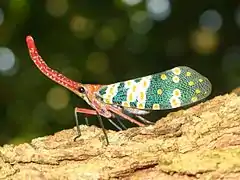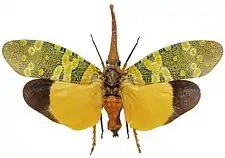Pyrops candelaria
Pyrops candelaria (Laternaria candelaria and Fulgora candelaria in older literature) is a species of planthopper[2] that lives in Cambodia, Vietnam, Hong Kong, Laos, Thailand and other parts of southeast Asia. It is the type of the genus Pyrops erected by Spinola in 1839. Members of this genus are sometimes called lanternflies (although lanternflies do not emit light). Like all Fulgoridae, P. candelaria feeds on plant sap: including longan and lychee trees (Sapindaceae), among others. Its long, slender proboscis is used to pierce tree bark to reach the phloem.
| Pyrops candelaria | |
|---|---|
 | |
| Scientific classification | |
| Kingdom: | Animalia |
| Phylum: | Arthropoda |
| Class: | Insecta |
| Order: | Hemiptera |
| Infraorder: | Fulgoromorpha |
| Family: | Fulgoridae |
| Genus: | Pyrops |
| Species: | P. candelaria |
| Binomial name | |
| Pyrops candelaria | |
| Synonyms | |
They are often sought-out by collectors, attracted by their fore wings (see figure), yellow-orange hind wings with a black zone around the wing tips, a reddish head and cephalic process with white spots.

References
- Linné C. (1758) II. Hemiptera, In: Linné C. 1758 - Systema Naturae. Editio Decima, reformata, 1. p. 434-439.
- Kershaw, J. C.; Kirkaldy, G. W. (1910). "A memoir on the anatomy and life history of the homopteran insect, Pyrops candeleria (or candle-fly)". Zoologische Jahrbücher. Abteilung für Systematik. Geographic and Biologie. 29: 108–124.